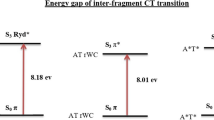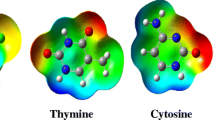Abstract
Hydrogen bonding interactions between thymine nucleobase and 2′-deoxythymidine nucleoside (dT) with some biological anions such as F− (fluoride), Cl− (chloride), OH− (hydroxide), and NO3 − (nitrate) have been explored theoretically. In this study, complexes have been studied by density functional theory (B3LYP method and 6-311++G (d,p) basis set). The relevant geometries, energies, and characteristics of hydrogen bonds (H-bonds) have been systematically investigated. There is a correlation between interaction energy and proton affinity for complexes of thymine nucleobase. The nature of all the interactions has been analyzed by means of the natural bonding orbital (NBO) and quantum theory atoms in molecules (QTAIM) approaches. Donors, acceptors, and orbital interaction energies were also calculated for the hydrogen bonds. Excellent correlations between structural parameter (δR) and electron density topological parameter (ρ b) as well as between E(2) and ρ b have been found. It is interesting that hydrogen bonds with anions can affect the geometry of thymine and 2′-deoxythymidine molecules. For example, these interactions can change the bond lengths in thymine nucleobase, the orientation of base unit with respect to sugar ring, the furanose ring puckering, and the C1′–N1 glycosidic linkage in dT nucleoside. Thus, it is necessary to obtain a fundamental understanding of chemical behavior of nucleobases and nucleosides in presence of anions.






Similar content being viewed by others
References
Kolandaivel P, Nirmala V (2004) J Mol Struct 694:33
Reed AE, Curtiss LA, Weinhold FA (1988) Chem Rev 88:899
Dolgounitcheva O, Zakrzewski VG, Ortiz JV (2008) J Phys Chem A 112:10399
Lang LG, Riordan JF, Vallee BL (1974) Biochemistry 13:4361
Chmielewski MJ, Jurczak J (2006) Chem Eur J 12:7652
Quinonero D, Garau C, Frontera A, Ballester P, Costa A, Deya PM (2002) Chem Phys Lett 359:486
Beer PD, Gale PA (2001) Angew Chem Int Ed 40:486
Aliakbar Tehrani Z, Fattahi AR (2009) J Mol Struct THEOCHEM 913:277
Hay BP, Bryantsev VS (2008) Chem Commun 2417
Mascal M, Armstrong A, Bartberger MD (2002) J Am Chem Soc 124:6274
Hartmann M, Wetmore SD, Radom L (2001) J Phys Chem A 105:4470
Robinet JJ, Baciu C, Cho K, Gauld JW (2007) J Phys Chem A 111:1981
Shishkin OV, Palamarchuk GV, Gorb L, Leszczynski J (2006) J Phys Chem B 110:4413
Lamsabhi AM, Mo O, Yanez M, Boyd RJ (2008) J Chem Theory comput 4:1002
Auffinger P, Bielecki L, Westhof E (2004) Structure 12:379
Bader RFW (2002) AIM2000 program package, Ver. 2.0. McMaster University, Hamilton, Ontario, Canada
Spartan 06V102 (2004) Wavefunction, Inc., Irvine, CA, USA, p 399
Bader RFW (1990) Atoms in molecules: a quantum theory. Clarendon Press, Oxford University, Oxford
Liu M, Li T, Sedinam Amegayibor F, Cardoso DS, Fu Y, Lee JK (2008) J Org Chem 73:9283
Nguyen MT, Chandra, Zeegers-Huyskens T (1998) J Chem Soc Faraday Trans 94:1277
Huang Y, Kenttämaa H (2003) J Phys Chem A 107:4893
Kryachko ES, Zeegers-Huyskens T (2002) J Phys Chem A 106:6832
Shishkin OV, Pelmenschikov A, Hovorun DM, Leszczynski J (2000) J Mol Struct 526:329
Altona C, Sundaralingam M (1972) J Am Chem Soc 94:8205
Jeffrey GA, Saenger W (1994) Hydrogen bonding in biological structures. Springer, Heidelberg
Saenger W (1988) Principles of nucleic acid structures. Springer, New York
Galvez O, Gomez PC, Pacios LF (2003) J Chem Phys 118:4878
Huang Z, Yu L, Dai Y (2010) Int J Quantum Chem. doi:10.1002/qua.22772
Bondi A (1964) J Phys Chem 68:441
Arnold WD, Oldfield E (2000) J Am Chem Soc 122:12835
Koch U, Popelier PLA (1995) J Phys Chem 99:9747
Abboud JLM MOO, De Paz JLG, Yanez M, Esseffar M, Bouab W, El-Mouhtadi M, Mokhlisse R, Ballesteros E, Herreros M, Homan H, Lopez-Mardomingo C, Notario R (1993) J Am Chem Soc 115:12468
Rozas I, Alkorta I, Elguero J (2000) J Am Chem Soc 122:11154
Bader RFW (1991) Chem Rev 91:893
Acknowledgement
Support from Sharif University of technology is gratefully acknowledged.
Author information
Authors and Affiliations
Corresponding author
Electronic supplementary material
Below is the link to the electronic supplementary material.
Rights and permissions
About this article
Cite this article
Shakourian-Fard, M., Fattahi, A. Theoretical investigation on the structural and electronic properties of complexes formed by thymine and 2′-deoxythymidine with different anions. Struct Chem 23, 17–28 (2012). https://doi.org/10.1007/s11224-011-9837-5
Received:
Accepted:
Published:
Issue Date:
DOI: https://doi.org/10.1007/s11224-011-9837-5




